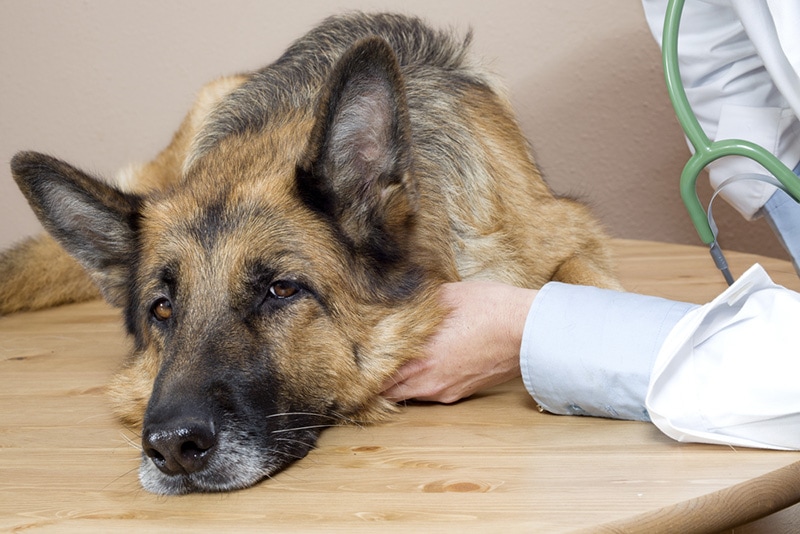
Liver disease in dogs can look vastly different in different dogs. We can see liver disease in dogs of all age groups, each one having certain conditions that may be more common. Your veterinarian will likely recommend a series of tests to determine if your dog has liver disease and to help determine what type of liver condition they have. Only after your veterinarian has a diagnosis can they recommend the best course of treatment.
Continue reading to learn more about liver disease in dogs, the causes, signs, and recommended care.
What Are Different Types of Liver Disease in Dogs?
There are too many different types of liver disease in dogs to discuss all in one article. We will focus on some of the most common ones.

What Are the Signs of Liver Disease in Dogs?
Unfortunately, the first signs of liver disease are very non-specific. This means that when your dog gets sick at first, the signs can be common for many other diseases. Most commonly, we are going to see a decreased appetite, which often progresses to complete anorexia, vomiting, diarrhea, and general lethargy or malaise.
If your puppy or young dog has a shunt, you may notice abnormal neurologic signs that can be intermittent but commonly occur after eating. This may include wobbliness, seizures, collapse, and difficulty walking.
As liver disease progresses, your dog may develop jaundice or yellowing of the skin, eyes, and tissues. This can be most commonly seen in the whites of the eyes, the gums, inside the ears, and on the belly.
In many types of liver disease, the liver will become very enlarged. You may start to notice that your dog has a pot-belly or rounded appearance to their abdomen. If your dog has a tumor, you may think the abdomen is getting larger or more rounded, but it’s actually the tumor causing abdominal distension.
In the later stages of liver disease, fluid build-up in the abdomen is also very common. This can appear similar to the above—a rounded, slightly pot-bellied appearance to the abdomen. The more it progresses, you may be able to see a “fluid wave” of the abdomen, and your dog will likely start to have trouble breathing.

What Are the Causes of Liver Disease in Dogs?
A porto-systemic shunt, or abnormal blood flow through the liver, is something your dog is born with. In rare instances, these can be acquired or happen secondary to another underlying liver condition. At this time, studies have not concluded if there is a clear-cut genetic link to shunts. What studies have shown is that small breed dogs most commonly have extrahepatic shunts or abnormal blood flow outside the liver. Large breed dogs most commonly have intrahepatic shunts or abnormal blood flow inside of the liver.
Liver toxicity can occur from ingestion of a number of toxins. These toxins can affect the liver in different ways. Some toxins will cause death of the liver cells and eventually liver failure from liver necrosis. Other toxins, such as mushrooms and blue-green algae will produce liver-damaging compounds. Some toxic medications may increase the blood pressure within the liver, referred to as portal hypertension, and this will then secondarily damage the liver.
Liver cancer can be benign and malignant. Benign cancers mean that there may be a tumor or mass, but it does not typically metastasize or spread to other internal organs. Malignant cancers are cancers that will spread internally, such as to the lungs, spleen, etc. Numerous studies across the country, in both veterinary and human medicine, are looking at what causes liver cancers. At this time, there are no clear causes.
Vacuolar hepatopathy can occur secondary to Cushing’s disease, diabetes, or any underlying condition, which may cause chronic release of steroids within the body (endogenous steroids). This will then cause the liver cells to become distended or enlarged, creating vacuoles. This condition can also be caused by long term administration and/or high-dose steroid administration.

How Do I Care for a Dog with Liver Disease?
The exact care needed for your dog with liver disease will depend on what their exact disease is. With vacuolar hepatopathy, care, and treatment are aimed at treating the condition that causes vacuolar hepatopathy.
However, because almost all dogs with liver disease suffer from a decreased appetite and/or anorexia, nausea, diarrhea, and an overall feeling of malaise, there are some treatments common across the board. Your veterinarian will likely prescribe either injectable or oral anti-vomiting medications and appetite stimulants. If your dog has diarrhea, they are often put on probiotics long-term.
In most dogs with liver disease, a bland but palatable diet is typically recommended. You never want to try and entice your dog to eat fatty, oily, or heavily seasoned foods. And human fast food is always out of the question. Work with your veterinarian to develop a diet that your dog will want to eat and won’t cause them any further gastrointestinal distress. Your veterinarian may even recommend a prescription liver diet for your dog.
If your dog has a shunt or certain types of tumors, surgery may be recommended. Depending on the type of shunt, the type of tumor, how large either one is, the size of your dog, and many other factors, your veterinarian will make the best recommendation for your dog. Surgeries for a shunt are typically very specialized and your dog may need to go to a specialty hospital or even a university veterinary hospital. Please discuss the best treatment options available for your dog and their specific case.
Frequently Asked Questions (FAQs)
1. Is Liver Disease in Dogs Fatal?
Unfortunately, this is not a cut-and-dry question and answer. Many types of liver disease can greatly shorten your dog’s lifespan. Many others may have surgical or medical treatment options, but your dog still may not live a full, healthy life. Still, some toxins, shunts, and tumors can be treated and cured. Other toxins, such as sago palm, are highly fatal.

2. What Types of Testing Are Needed to Diagnose Liver Disease in My Dog?
The first line of testing is almost always bloodwork. This will help tell your veterinarian if the liver values are abnormal, and if so, which ones. From there, more blood work may be needed to determine a cause. Other times, your dog may need some type of imaging, such as an abdominal ultrasound or a CT scan. In any case, your veterinarian should help walk you through the step-by-step process for diagnosis.
 Conclusion
Conclusion
Liver disease in dogs can have many faces. Some diseases, such as shunts, are problems your dog is born with. There are many, many things your dog can eat that can cause serious or even fatal liver disease. Still, other dogs suffer from liver cancer. Your veterinarian will likely start with blood work, and then work through testing to try and determine what type of liver disease your dog has.
Once a diagnosis has been made, your dog can pursue the best treatment to help them feel better, and potentially even cure them. Some dogs will require lifelong care for liver disease. In any case, if your dog starts to vomit, has diarrhea, has a decreased appetite, or you notice a yellowing of their skin, you should seek veterinary medical attention immediately.
Related Read:
- Understanding & Caring For Von Willebrand’s Disease in Dogs
- Lyme Disease in Dogs: Symptoms, Treatment, Prevention
Featured Image Credit: Lindsay Helms, Shutterstock






